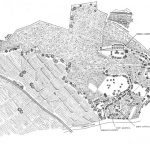-
Editorial
October 2013
Sri Lanka is a stunningly green landscape. Its naturally fertile lands, and the ever growing green jungles and fields sit just beyond the chaotically built-fabric of the cities and towns. In the past, small peasant houses with verandahs covered in thatch dotted this landscape in small hamlets while tile-roofed temples and white-washed dagobas occupying higher grounds overlooked them. Terraced paddy fields exposed the fertility of the ground every season and produced layers of green, turning to yellow when the harvesting time came. Water was in abundance and meandered through smaller springs joining a network of rivers that originated in the higher mountains eventually reaching the Ocean. Springs coming down the mountains became waterfalls adding mystery and joy to the visual spectacles. Large swathes of land remained virgin forests producing the fauna and flora. Together, they enriched the land and also provided natural ingredients for the sustenance of its people.
As if that was not enough to call this Island the ‘blessed land’, which Sri Lanka literally meant, Man had added his own too. A century ago, the British, through an unwanted colonisation of the land destroyed the virgin forest, which was fiercely opposed. Nevertheless, they had conquered and cultivated the mountains to produce their favoured drink, tea. Eventually though, the undulating green tea estates covered the hilltops like an endless carpet and transformed them to an enchanting green landscape. Multi-storied tea factories clad in steel dotted this landscape and sat under blue and white cloudy skies that brought continuous mists across the mountains. The hill country had become even more stunning although the forests had gone.
Perhaps there never was a question of greening these landscapes, for it was even before the words were coined to usurp the debate on sustainability, that this was a land of Man and earth living in harmony with each other. Monks and the peasants who inhabited Sri Lankan villages knew that the earth was precious and sought constantly to treat its bountiful resources with reverence and care despite the abundance.
Today however, much of it is changing, and changing very fast. Architects are perhaps partly to be blamed for this blunder, but certainly not all. Likes of Minnett De Silva, Ulrik Pleasner, Geoffery Bawa and Ashley De Vos, had seen and understood the value of the Sri Lankan landscape and the underlying forces that had given rise to and sustained its splendor. They inculcated a way of seeing, understanding and building upon those forces to produce marvelous architecture. Impossible to be captured through the uninspiring language of sustainability science, their buildings have been true to the earth and its nuances of materiality and spirituality only the genius could imagine. They were indeed green in the fullest sense and continue to inspire the new generation. In this issue of the SLIA journal, we look at the phenomena of ‘touching the earth gently’, the Sri Lankans had mastered in building in the past, but have now forgotten. The architects are re-inventing this sensitivity whose buildings and spaces will yet again re-infuse this land with spaces that are sincere to the earth. Let us celebrate their genius and commitment to a better world around us.
Archt. Prof. Ranjith Dayaratne













